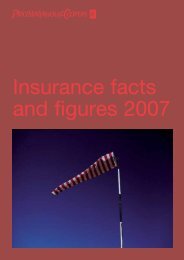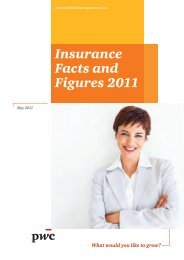Controlling fraud in the public sector - PricewaterhouseCoopers
Controlling fraud in the public sector - PricewaterhouseCoopers
Controlling fraud in the public sector - PricewaterhouseCoopers
Create successful ePaper yourself
Turn your PDF publications into a flip-book with our unique Google optimized e-Paper software.
Figure 4: Profile of <strong>in</strong>ternal <strong>fraud</strong>sters<br />
2009<br />
Middle management<br />
42%<br />
Senior management<br />
14%<br />
O<strong>the</strong>r employees<br />
44%<br />
2007<br />
Middle management<br />
Senior management<br />
26%<br />
26%<br />
O<strong>the</strong>r employees<br />
48%<br />
0% 10% 20% 30% 40% 50% 60%<br />
Percentage of all respondents<br />
Middle management<br />
24%<br />
42%<br />
Senior management<br />
14%<br />
24%<br />
O<strong>the</strong>r employees<br />
44%<br />
49%<br />
0% 10% 20% 30% 40% 50% 60%<br />
Percentage that committed <strong>fraud</strong><br />
All <strong>in</strong>dustries<br />
Government organisations<br />
In contrast, with<strong>in</strong> government and state-owned enterprises,<br />
<strong>the</strong> number of crimes committed by middle management has<br />
rema<strong>in</strong>ed steady at 24%. In <strong>the</strong> government <strong>sector</strong>, junior<br />
managers are most likely to commit <strong>fraud</strong> (49%) but senior<br />
executives committed 24% of economic crime, significantly<br />
higher than <strong>the</strong> all-<strong>in</strong>dustries figure of 14%.<br />
Why do people commit <strong>fraud</strong>?<br />
Fraud <strong>in</strong>vestigators often po<strong>in</strong>t to three common factors<br />
when <strong>fraud</strong> occurs (<strong>the</strong> ‘<strong>fraud</strong> triangle’). First, perpetrators<br />
of <strong>fraud</strong> need an <strong>in</strong>centive or pressure to engage <strong>in</strong><br />
misconduct. Second, <strong>the</strong>re must be an opportunity to<br />
commit <strong>fraud</strong>, and third, perpetrators are often able<br />
to rationalise or justify <strong>the</strong>ir actions.<br />
The PwC Global Economic Survey found that:<br />
• 71% of respondents attributed greater risk of <strong>fraud</strong><br />
to <strong>in</strong>creased <strong>in</strong>centives or pressures<br />
• 15% claimed “more opportunities” as <strong>the</strong> most likely<br />
reason for greater risk of <strong>fraud</strong><br />
• 12% believed that people’s ability to rationalise was<br />
<strong>the</strong> ma<strong>in</strong> factor contribut<strong>in</strong>g to greater risk of <strong>fraud</strong>.<br />
What’s beh<strong>in</strong>d <strong>the</strong>se perceptions? In <strong>the</strong> <strong>public</strong> <strong>sector</strong>,<br />
<strong>the</strong> survey found that <strong>the</strong> most commonly reported factor<br />
motivat<strong>in</strong>g people to commit <strong>fraud</strong> was fear of los<strong>in</strong>g<br />
<strong>the</strong>ir jobs.<br />
Globally, this pressure is set to <strong>in</strong>crease with <strong>the</strong> expected<br />
cuts across <strong>the</strong> <strong>public</strong> <strong>sector</strong> <strong>in</strong> <strong>the</strong> next 12 to 18 months.<br />
While arguably this pressure is not as great <strong>in</strong> Australia<br />
with its relatively stable government workforce, staff can<br />
still be motivated to commit <strong>fraud</strong> by <strong>the</strong> loss of promotion<br />
or <strong>the</strong> lack of job opportunities.<br />
Figure 5: The <strong>fraud</strong> triangle –<br />
Why do people commit <strong>fraud</strong>?<br />
Figure 5: The <strong>fraud</strong> triangle – Why do people commit <strong>fraud</strong>?<br />
Incentive or<br />
pressure<br />
71%<br />
Fraud<br />
Opportunity<br />
15%<br />
Attitude /<br />
rationalisation<br />
12%<br />
Fight<strong>in</strong>g <strong>fraud</strong> <strong>in</strong> <strong>the</strong> <strong>public</strong> <strong>sector</strong> 9
















